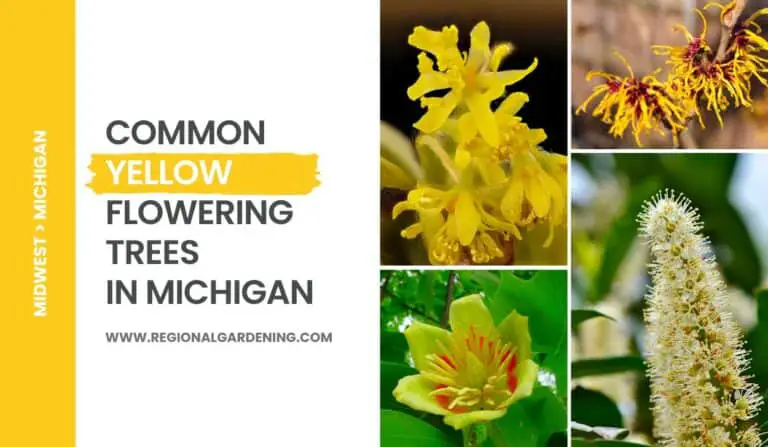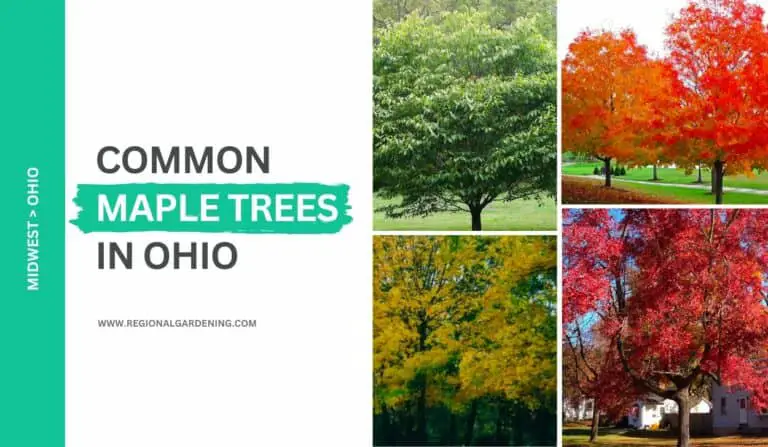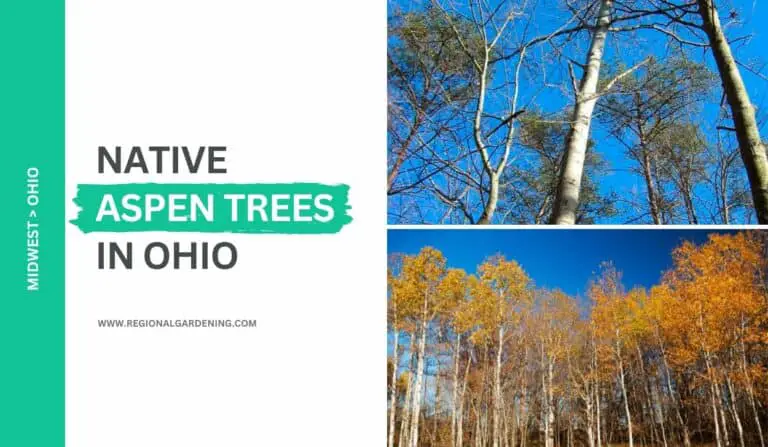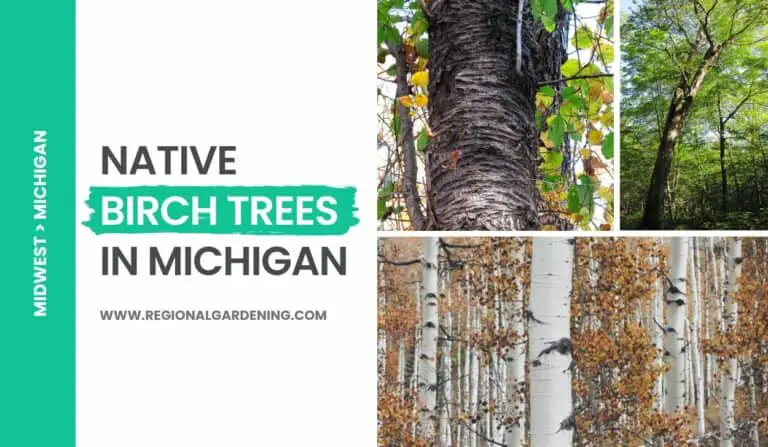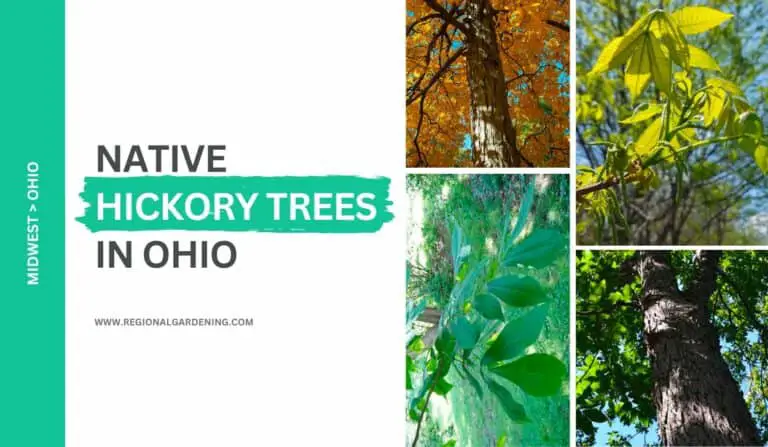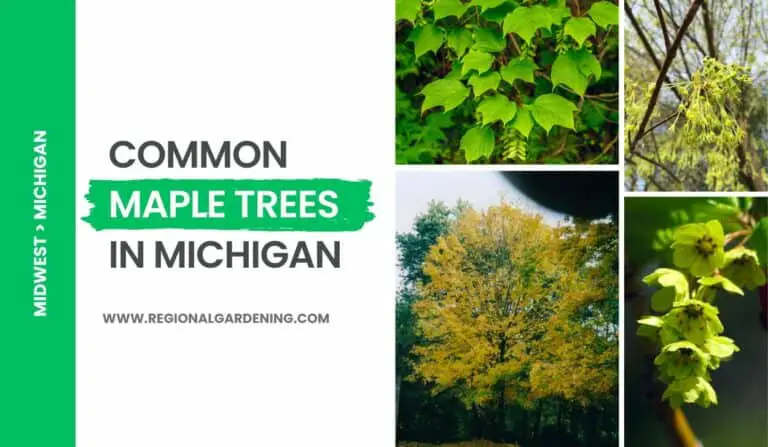7 Common Ash Trees In Ohio (All You Need To Know)

Did you know that Ohio is home to a variety of ash trees? They are commonly found in forests, parks, and along the streets of residential areas.
However, with the emergence of the Emerald Ash Borer (EAB) insect, which feeds on the inner bark of ash trees and causes their death, it is crucial to learn how to identify and protect these valuable trees.
In this article, we will discuss the different types of ash trees in Ohio including native and non-native naturalized varieties. Additionally, we’ll cover three species that are not truly ash but are commonly counted along with ash trees.
So, let’s get started.
1. Blue Ash
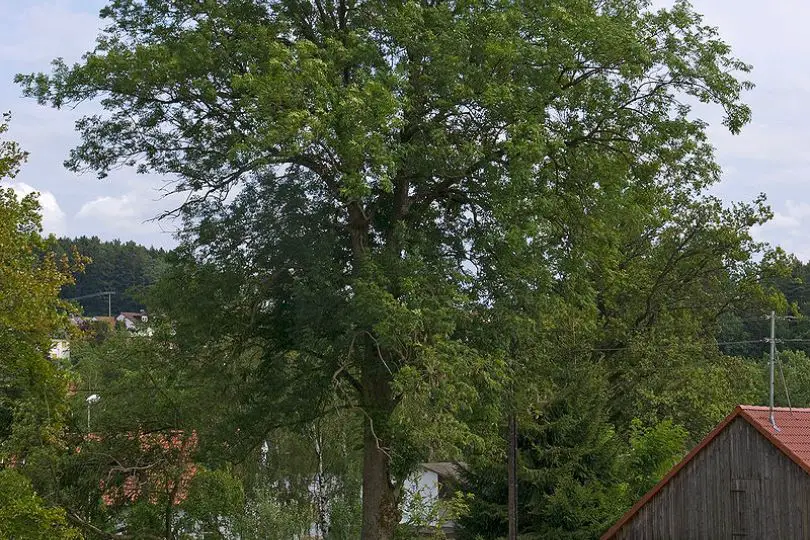
- Common Name: Blue Ash
- Scientific Name: Fraxinus quadrangulata
- Mature Height: 50-70 feet (15-21 meters)
- Native/Non-Native: Native
- Flowers: none, produces green-winged seeds
- Uses: lumber, shade tree, dye-making
One of the most commonly found ash trees in Ohio, the blue ash tree is a medium-sized tree that has a single straight trunk with a spreading uneven crown and can grow up to 70 feet tall.
It has compound leaves that are 8-12 inches long and made up of 5-11 stalkless leaflets. The leaflets are toothed, pale green on top, and contain tufts of hair along the midrib on the bottom.
Blue ash bark is light brown and becomes scaly, fractured, loose, and shaggy as it ages. The tree produces green-winged seeds that grow to brown, are 1-2 inches long, and remain on the tree throughout the winter.
The sap of the Blue Ash tree turns color to blue when exposed to air, giving rise to the tree’s popular name. This blue dye, which was prepared from shattered inner bark and water, was used to color textiles.
One of the most drought-resistant native ash trees is the Blue Ash. It grows in a wide range of environments, including moist and dry soils, limestone outcroppings, and sunlight. As a result, it is a popular choice for landscaping in parks, yards, and along streets. It also provides lumber and shade, making it an important aspect of Ohio’s ecosystem.
2. Black Ash
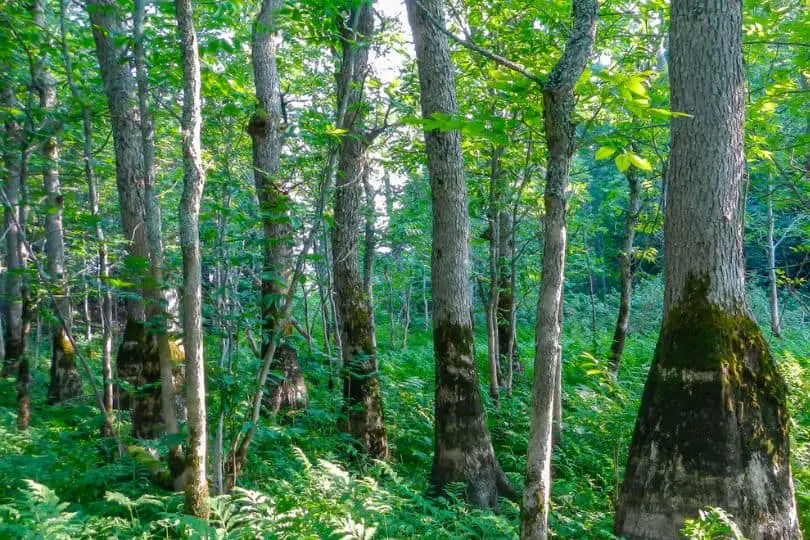
- Common Name: Black Ash
- Scientific Name: Fraxinus nigra
- Mature Height: 40-50 feet
- Native/Non-Native: Native
- Flowers/Cones: Green flowers and green-winged seeds (samara)
- Uses: Basketweaving, snowshoe frames, canoe ribs
After blue ash, Black Ash trees are the most commonly found ash trees in Ohio. It is a lovely tree that may be found all over the United States. It is sometimes referred to as Swamp Ash since it grows near water and can withstand standing water for several weeks.
This tree is tall and thin, with a narrow, erect crown. The trunk is frequently leaning or bowed, and the bark is light gray, corky, and flaky.
The leaves of Black Ash are compound and oppositely connected. They are composed of 7-13 small tapering leaflets with pointy tips and finely serrated margins. Their leaflets are not stalked like those of other ash species. The yellowish-green leaves can grow up to 17 inches long.
The fruit of the Black Ash is one of its distinguishing characteristics. The fruit is a green-winged seed, commonly known as a samara, that matures to brown. Samaras are typically 1-2 inches long and grow in clusters that remain on the tree throughout the winter.
The Black Ash is well-known for its cherries, which are popular with birds and mammals. The seeds normally germinate two years after they fall from the tree and provide good seed production every five to seven years.
Because the fresh green wood sliced into strips can be used to create baskets, snowshoe frames, and canoe ribs, this tree is also known as Basket Ash or Hoop Ash.
The Black Ash, being a native tree that has been used for practical reasons for ages, should be celebrated and preserved for future generations to enjoy.
3. White Ash
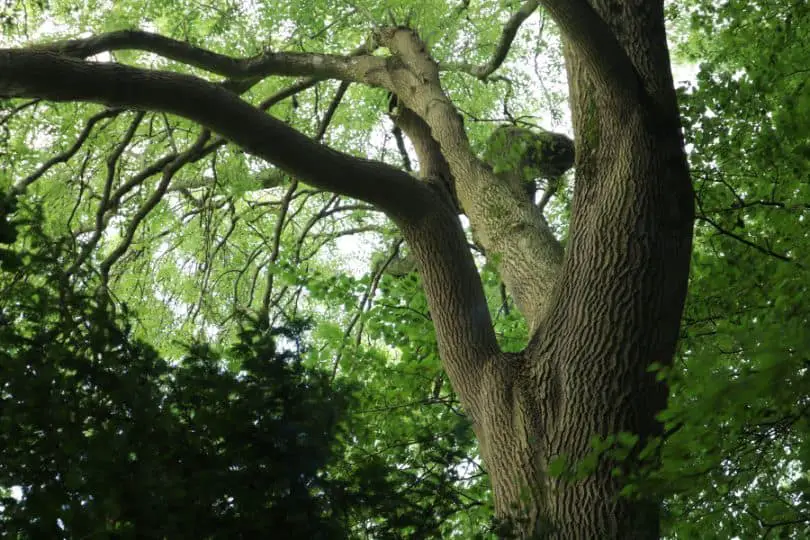
- Common Name: White Ash
- Scientific Name: Fraxinus americana
- Mature Height: 40-60 feet
- Native/Non-Native: Native
- Flowers/Cones: Green-winged seed (samara)
- Uses: Wood is used to make baseball bats, snowshoes, and hockey sticks
The White Ash is a stunning natural tree that can reach heights of 60 feet. It features a single straight stem and a circular, thin crown.
Its leaves range in length from 8 to 12 inches and are made up of seven oval leaflets. Each leaflet is around 3 to 5 inches long and may or may not include teeth. Its vivid green leaves are darker on top and lighter on the bottom. The “White” in White Ash is derived from their light underside.
The White Ash is distinguished by diamond-shaped ridges on its greenish-gray bark. In the fall, its seeds, known as samaras, can be found on the tree. When ripe, these green-winged seeds turn brown and have a notch or rounded wing tip. The samaras are normally 1 to 2 inches long and stay on the tree all winter.
White Ash is a high-quality wood that is used to produce baseball bats, snowshoes, and hockey sticks. Its straight-grained wood is ideal for various purposes. The White Ash also produces seeds on an annual basis, as well as vast quantities of seeds every 2 to 5 years.
The cherries are one of the White Ash’s distinguishing characteristics. The tree has clusters of small, spherical, meaty berries the size of a pea that matures in late summer and early fall. These cherries are a favorite diet of birds such as cedar waxwings and robins.
4. Green Ash
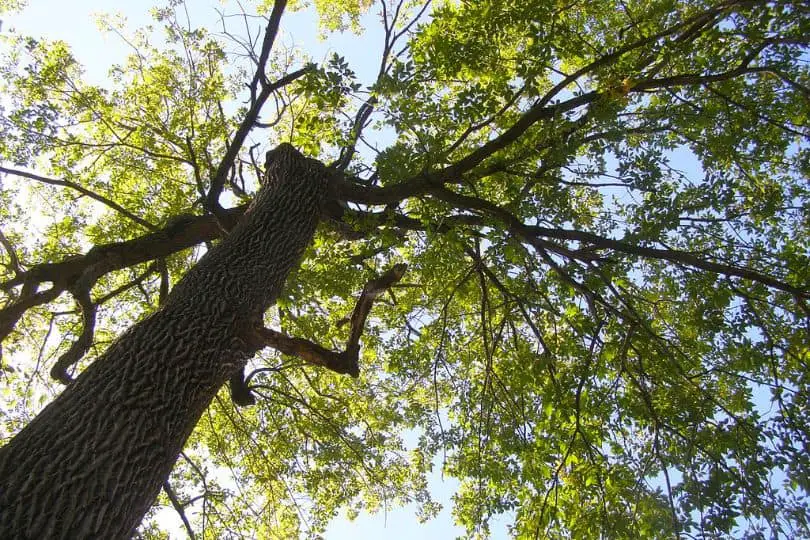
- Common Name: Green Ash
- Scientific Name: Fraxinus pennsylvanica
- Mature Height: 50-60 feet (15-18 meters)
- Native/Non-Native: Native
- Flowers/Cones: Flowers
- Uses: Baseball bats, skis, and snowshoes
The Green Ash tree has a single straight trunk with rising branches. These trees are distinguished by their uneven crown and compound leaves with 5-9 leaflets attached oppositely. Each leaflet can grow to be up to 2 inches long and has either no teeth or a very finely-toothed edge.
Green Ash is most commonly found in damp soils, beside streams, in lowland woods, and the shade. It is a common ash tree in Ohio and a popular species of ash tree. The tree’s bark is brown, with deep furrows and narrow interlacing ridges that appear diamond-shaped.
The fruit of the Green Ash tree is one of its most intriguing features. The tree produces green-winged seeds, sometimes known as samaras, that grow to brown. They can grow up to 2 inches long, are typically round-ended, and sometimes notched, and are found in groups. These fruits frequently survive the winter on the tree.
Green Ash is not just beautiful; its durable white wood is used to make baseball bats, skis, and snowshoes. So, the next time you use one of these items, keep in mind that it was most likely produced from the wood of the Green Ash tree.
If you happen to come upon a Green Ash tree, you should look into the cherries that grow on it. They are small and dark crimson, with a slightly acidic flavor. You can eat them straight off the tree or use them to make jams and jellies. So, the next time you see a Green Ash, take a closer look at the lovely tree and its delectable cherries.
5. American Mountain Ash
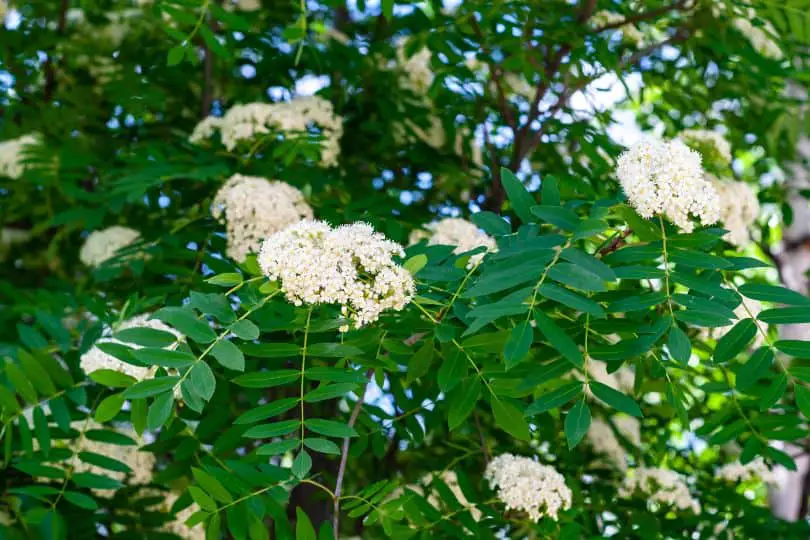
- Common Name: American Mountain Ash
- Scientific Name: Sorbus americana
- Mature Height: 15–30′ (4.5–9 m)
- Native/Non-Native: Native
- Flowers/Cones: Creamish yellow flowers
- Uses: Ornamental planting
Sorbus americana, often known as American Mountain-ash, is a tiny tree that can grow to be 15-30 feet tall. Although it is commonly counted among ash trees in Ohio, they are not true ash and are a member of the Rosaceae rose family.
The tree has a spherical crown and can be mistaken for a shrub with many trunks. Its leaves are complex and alternately connected, having 11-17 lance-shaped leaflets with fine sharp teeth. The leaflets are pale green and can grow to be 2-4 inches long.
The bark of the American Mountain ash is light gray and scaly as it ages. The tree yields white-to-cream blooms 14 inches wide that grow in flat clusters 3-5 inches wide.
The fruit of the American Mountain-ash is a vivid orange or red berry-like pome that is 14 inches in diameter and hangs in 3-5 inch broad clusters. These berries are edible, with a flavor comparable to sour cherries. The fruit is a favorite of Cedar Waxwings and Ruffed Grouse, who eat it frequently.
Because of its spectacular flowers and colorful berries, American Mountain ash is widely planted in landscapes. It is a slow-growing ornamental tree that also serves as a deer feed. Yellow-bellied Sapsuckers adore this tree and drill rows of horizontal holes to drink the sap.
The American Mountain ash is a sun-sensitive tree that is prone to fire blight and sunscald. Its cultivated forms are frequently planted to attract birds.
6. Common Prickly Ash
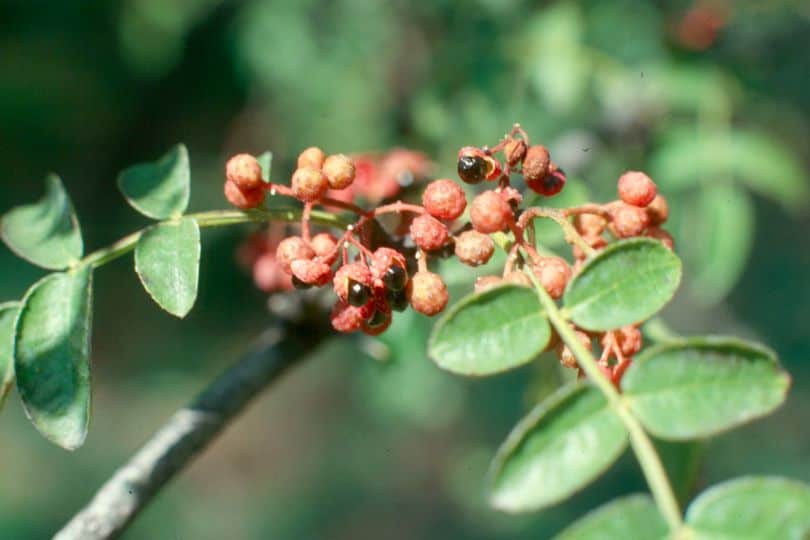
- Common Name: Common Prickly-ash
- Scientific Name: Zanthoxylum americanum
- Mature Height: 5-15 feet
- Native/Non-Native: Native
- Flowers/Cones: Small, green, and inconspicuous flowers on long stalks
- Uses: Used for the treatment of toothaches, and numbness in the mouth, and for its highly fragrant fruit.
Common Prickly ash is a tiny tree found in North America. It can reach a height of 5-15 feet and has a circular crown and single or several trunks. The tree has compound leaves that are alternately attached and are made up of 5-11 oval leaflets that are 1-2″ (2.5-5 cm) long. When the leaves are crushed, a citrus fragrance is released.
The tree’s bark is gray in hue, smooth, with dark gray lines and white spots. It is also covered in thick, sharp thorns that, if touched or brushed against, can cause harm.
The Common Prickly-ash has small, green flowers on long stalks and clusters of green berry-like fruits that ripen to vivid red color. When crushed, the fruit emits a sweet aroma reminiscent of oranges, lemons, and limes.
The fruit and inner bark of the tree contain zanthoxylin, a citrus-scented oil that causes tongue numbness. The tree is also known as the Toothache Tree due to its healing powers.
The Common Prickly-ash is a natural species that grows in a wide range of soil types, along forest borders, and in full sun to moderate shade. It spreads through underground roots, establishing dense stands along forest borders.
Zanthoxylum is a Greek genus name that means “yellow wood” and describes the hue of the wood. Finally, the Common Prickly ash is a fascinating tree with many distinct characteristics, such as its fragrant fruit, medicinal bark, and thorny exterior.
7. European Mountain Ash
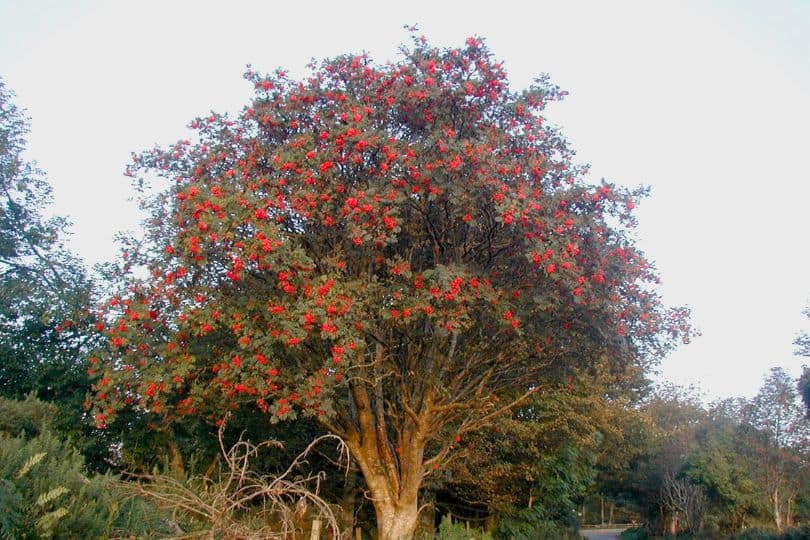
- Common Name: American Mountain Ash
- Scientific Name: Sorbus aucuparia
- Mature Height: 15–25′ (4.5–7.5 m)
- Native/Non-Native: Non-Native
- Flowers/Cones: Green flowers
The European Mountain-ash, also known as Sorbus aucuparia, is a magnificent tree that was imported to North America from Europe. It can reach a height of 15-25 feet and has a single stem with ascending branches and a circular crown.
The complex leaves are connected alternately and have 9-17 oval leaflets. Each leaflet measures 1-2 inches in length and has a finely serrated edging. The leaves are dull green above and pale below, with a yellowish central stalk.
In the spring, the tree bears little greenish blooms approximately 14 inches across in flat clusters 3-5 inches wide. The leaves turn a gorgeous yellow color in the fall. The most intriguing aspect of European Mountain ash is its fruit.
The fruit is an orange-to-red berry-like structure 14 inches in diameter. They grow in 3-5 inch long hanging clusters, with each fruit containing 1-2 lustrous black seeds.
The berry-like fruit is popular among birds such as yellow-bellied sapsuckers and serves as an excellent source of food for wildlife. The fruit is also strong in vitamin C, which was historically used to treat scurvy. The fruit was previously used to bait bird traps, which is why the Latin species name aucuparia comes from avis and capere, which means “to catch birds.”
Even though it is listed under ash trees in Ohio, European Mountain ash is not a real ash tree and is commonly planted in parks, yards, and along highways. It belongs to the Rose family and resembles the American Mountain ash except for the yellowish central stem. It is well-known for its stunning beauty and cherry-like fruit.
Similar Articles
- White Flowering Trees In Ohio
- Yellow Flowering Trees In Ohio
- Common Oak Trees In Ohio
- Common Nut Trees In Ohio
- Common Willow Trees In Ohio
- Common Purple Trees In Ohio
- Common Pine Trees In Ohio
- Common Birch Trees In Ohio
- Native Cherry Trees In Ohio
- Native Hickory Trees In Ohio
- Common Elm Trees In Ohio
- Common Spruce Trees In Ohio
- Common Poplar Trees In Ohio
- Native Plum Trees In Ohio
- Common Maple Trees In Ohio
- Common Cedar Trees In Ohio
- Native Aspen Trees In Ohio
- Common Locust Trees In Ohio
- Common Palm Trees In Ohio
Common Ash Trees in Ohio – Sources
The Regional Gardening team makes sure that the information in our articles is accurate by only using sources that are known to be trustworthy. Some of these sources are peer-reviewed journals from government agencies, well-known universities, and scientific research organizations.
- Trees Of Ohio, Division Of Wildlife
- Trees Of Ohio Field Guide, Book by Stan Tekiela
- Ohio Trees, OSU Extension Publications
- Native Plant Lists, Ohio Department Of Natural Resources
- Ohio Department Of Agriculture
- Gardening, The Ohio State University


